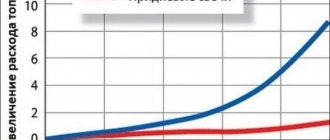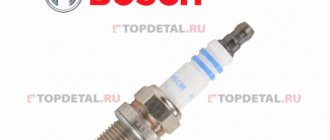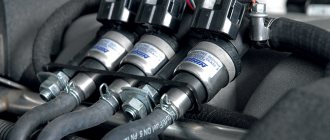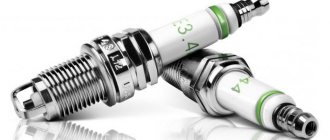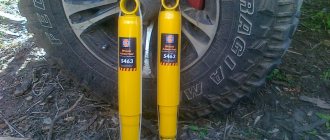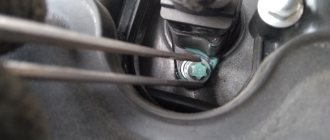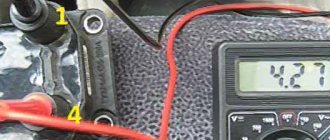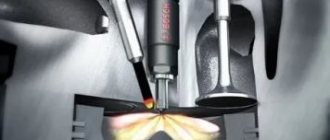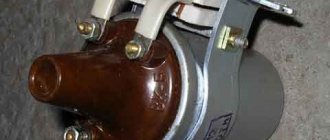At the moment, the Japanese company NGK Spark Plug Co., Ltd. confidently holds the title of world leader in the production of spark plugs for almost all gasoline-powered equipment: from small-capacity lawnmower engines to multi-liter trucks. NGK spark plugs are a “strong middle ground”; they are guaranteed to be able to withstand the specified parameters at the required mileage, without emphasizing any one parameter to the detriment of overall functionality. Therefore, NGK maintains its leadership in supplies directly to car factories. What is important to them is that “original” (i.e., purchased from a third-party supplier under their own brand) spark plugs do not cause any problems during service runs throughout the entire warranty period.
NGK Technologies
The classic design of a spark plug seems to have remained unchanged for at least half a century. However, in modern conditions, when environmental requirements are constantly growing, such candles are of little use. The relatively large area of the electrodes on which the discharge occurs requires an increase in voltage; the spark itself, “floating” on the surface of the electrodes, does not guarantee strict maintenance of the torque and speed of propagation of the flame front.
The V-Line technology developed by the company has become a simple and effective solution to the problem for most internal combustion engines. The essence of the technology is to apply a V-shaped groove to the end of the central electrode, running parallel to the side electrode. Denso also uses essentially similar technology, but to circumvent NGK patents, they make a groove on the side electrode.
For spark plugs made using V-Line technology, while maintaining other parameters, the area of space in which sparking is possible is noticeably reduced. With the same ignition system, the electrostatic field strength between the electrodes increases, that is, the power and stability of the spark increases in comparison with traditionally designed spark plugs. In addition, the spark always jumps “from the edge”, where the spark gap is better ventilated - when operating on lean mixtures, this improves the stability of the engine, especially at idle.
NGK spark plugs with a semi-sliding surface discharge are interesting: unlike traditional multi-electrode designs, here the central electrode is completely recessed into the insulator.
The advantage of such products when working on rich mixtures or in worn-out engines: deposits of conductive carbon deposits here have little effect on the efficiency of the spark plug, and it becomes capable of working even with heavy contamination.
If we recall NGK or platinum iridium spark plugs, their advantages over classic ones are obvious: much more stable sparking due to the small diameter of the central electrode, and minimal erosion rates - and therefore the longest resource compared to other types. It is not for nothing that representatives of this line are installed in modern engines from the factory.
However, even here, NGK engineers found room for new experiments. The hybrid spark plugs they created have a central platinum electrode that works in tandem with a side electrode. The side electrode has a platinum solder and two additional electrodes that work on the same principle as is used in spark plugs with a semi-sliding surface discharge. When a spark plug becomes dirty, additional electrodes come into play, allowing the engine to operate stably until it warms up to the point where the carbon burns out.
NGK spark plugs
The NGK company is also originally Japanese, but they also have factories around the world, about 15 of them (Italy, France, Germany, Canada), but not in Asian countries (of course, with the exception of Japan).
Current and popular models
The most popular model is NGK V-Line BCPR6E-11 (catalog number 5282) or in common parlance NGK 11. Also popular are NGK Standard BPR6ES (7822), NGK LZKR6B-10E (1578).
Current range of NGK spark plugs:
| Name (electrode material/fuel/country of production | Minimum cost (for 1 piece) |
| NGK Standard (nickel, gasoline, Japan/France) | From 170 rubles |
| NGK Laser Iridium (iridium, gasoline, Japan) | From 630 rubles |
| NGK Laser Platinum (platinum, gasoline, Japan) | From 600 rubles |
| NGK V-Line (nickel, gasoline, Japan) | From 160 rubles |
| NGK Iridium IX (iridium, gasoline, Japan) | From 530 rubles |
| NGK Iridium MAX (iridium, gasoline, Japan) | From 630 rubles |
| NGK V-Power (nickel, gasoline, Japan) | From 180 rubles |
| NGK Iridium DF (iridium, gasoline, Japan) | From 900 rubles |
| NGK Platinum VX (platinum, gasoline, Japan) | From 300 rubles |
| NGK Racing (Platinum, Gasoline, Japan) | From 1200 rubles |
It is worth immediately noting that the NGK Iridium DF model is intended exclusively for the Japanese domestic market, which determines the price of these spark plugs. In turn, they have additional protection against carbon deposits, which no other model has.
For comparison, just like with Denso, let’s take nickel spark plugs (NGK V-Line) and iridium spark plugs (NGK Laser Iridium).
Decoding the NGK spark plug markings
The products of this company are coded with a formula like 123456-7.
- installation thread diameter and hexagon size (A – 18/25.4 mm, B – 14/20.8 mm, C – 10/16 mm, D – 12/18 mm, E – 8/13 mm, AB – 18/ 20.8 mm, BC – 14/16 mm, BK – 14/16 mm, DC – 12/16 mm). That is, for the usual VAZ car spark plugs, the first symbol in the marking should be B, for example.
- type of execution (P – protruding insulator, M – compact spark plug, U – with surface discharge).
- type of noise suppression (R – resistor, Z – inductance). On spark plugs that do not have additional noise suppression, the third familiarity is skipped (for example, in BP6ES).
- heat number. At NGK it is designated by numbers from 2 to 10, the direction of numbering is familiar to us according to the domestic standard (that is, “two” is the hottest, and “ten” is the coldest). The applicability of NGK in terms of heat rating and their compliance with the markings of other manufacturers can be described as follows:
- length of fastening thread (E – 19 mm, EH – 19 mm with shank partially without thread, H – 12.7 mm, L – 11.2 mm). If NGK does not have an O-ring, but a conical fit, then the letter F is used, and the thread length is, depending on the first sign element, 10.9 mm (plugs A), 11.2 mm (plugs B), 17.5 mm (plugs B *EF). For example, on the NGK AR8F the marking indicates a thread length of 10.9 mm with a conical seal. For compact spark plugs, this familiarity is skipped, since their thread length is always 9.5 mm.
- spark gap size. This familiar place is always separated by a hyphen, and if it is not in the marking, then a standard gap is set: for cars 0.8-0.9 mm, for motorcycles 0.7-0.8 mm. The gap is indicated in tenths of a millimeter as an integer, that is, 8 means a gap of 0.8 mm, and 15 means 1.5 mm.
- design features of the candle. There are many options here:
| B | Fixed contact nut |
| C.M. | Angled side electrode, compact design (insulator length 18.5 mm) |
| C.S. | Likewise |
| G,GV | Racing spark plugs |
| I | Iridium electrode |
| IX | Advanced Iridium Electrode |
| J | 2 specially shaped side electrodes |
| K | 2 side electrodes |
| -L | Intermediate heat number |
| -LM | Compact type (insulator length 14.5mm) |
| N | Special side electrode |
| P | Platinum electrode |
| Q | 4 side electrodes |
| S | Standard type |
| T | 3 side electrodes |
| U | Semi-surface discharge |
| VX | Platinum spark plug |
| Y | Center electrode with groove (V-Line series) |
| Z | Special design |
Let's decipher the NGK BPR5ES-11 marking as an example. It has a 14 mm connecting thread for a “21st” spark plug wrench, a protruding insulator, a conventional noise suppression resistor, a heat rating of 6, a threaded shank 19 mm long, a standard design, a spark gap of 1.1 mm. Let's carry out the reverse selection - let's say a single-electrode spark plug with a 10 mm thread for the “16th” spark plug has been removed from the car, the thread length is 19 mm, the heat number according to the table corresponds to the number 10 for NGK, the gap between the electrodes is 1 mm. Based on the known parameters, we are looking in the NGK catalog with the marking CPR10ES-10 (a classic type candle that matches the parameters of the existing one) or one that is as close as possible in marking.
Choosing NGK spark plugs for a car
However, this method is not very convenient. If we take into account the huge range of products produced by the company, then the best selection of NGK for a car is to use the company catalog, which is initially sorted by make, model, year of manufacture and engine size. It is available on the company’s website both in printable form (in the “Files for downloading” section, and in an interactive version (section “Product Selection”). Finding suitable candles here is not difficult, even for an old Moskvich:
How to spot a fake
The downside of popularity is the huge amount of counterfeit products on the market. To be convinced of this, you don’t even have to go to a car store: on Ebay or Aliexpress, type “spark plug” in the search, and it will immediately give you a huge number of candles in familiar packaging and, of course, from China. Such volumes of counterfeit goods have already seriously damaged the company’s reputation - in many car repair shops to this day, in case of any problems with ignition, the first answer is “You first install normal spark plugs, not NGK ones.”
So, how can you spot a fake on a display? Let's start with the packaging. The slightest “jambs” in printing clearly indicate a cheap counterfeit; the boxes of original candles are always perfect.
The workmanship itself speaks for itself.
The contact tip of the original NGK seems to be made in one piece with the spark plug: it is impossible to unscrew it with your fingers. Markings on the insulator and metal skirt must be clear and even. The threads on original products are rolled, so they are always smooth and even. The roughness of the carving and the marks of the chisel indicate a dubious origin. Crooked electrodes, especially deviation of the side electrode from the central axis, is also a reason to refuse the purchase.
With counterfeit V-Line spark plugs, the direction of the groove in the central electrode is almost always disrupted - if at the factory, when soldering the side electrode, it is centered exactly along the groove, then with “basement” plugs their mutual orientation can be absolutely any. For candles with electrodes made of noble metals, since they are much more labor-intensive to manufacture, the differences from “singed” ones are even more striking, since it is unprofitable to fully maintain complex technology in the conditions of “left-handed” production.
NGK candles. How to spot a fake! — DRIVE2
Prehistory The NGK company is the world's leading manufacturer of glow plugs, spark plugs, lambda probes (which are produced under the NTK trademark) and other components for internal combustion engines. How to distinguish ngk from fakes? It is not surprising that such a brand has many low-grade analogues and fakes. In order not to buy one of them, it is important to know the features of the original and its surrogates in person.
A fake has the following characteristics:
the upper nut of the terminal is easily unscrewed; the surface of the corrugations is rough, in addition, sometimes there are vertical lines on the insulator that look like cracks; the sealing ring is easily removed; the electrode is not firmly fixed in the insulator; poor thread quality (different pitch); the tip of the electrode is dirty.
Signs of original ngk products:
pleated (smooth) surface of the corrugations (no cuts, chips or cracks); the terminal nut is tightened firmly; the hexagonal part of the spark plug is marked with a four-digit number (marking only on the metal part); to remove the O-ring, you need to apply force.
